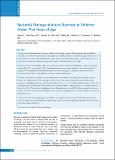Please use this identifier to cite or link to this item:
https://hdl.handle.net/20.500.14356/1944Full metadata record
| DC Field | Value | Language |
|---|---|---|
| dc.contributor.author | Ansari, S | - |
| dc.contributor.author | Sherchand, J B | - |
| dc.contributor.author | Parajuli, K | - |
| dc.contributor.author | Mishra, S K | - |
| dc.contributor.author | Dahal, R K | - |
| dc.contributor.author | Shrestha, S | - |
| dc.contributor.author | Tandukar, S | - |
| dc.contributor.author | Pokhrel, B M | - |
| dc.date.accessioned | 2023-06-02T06:25:11Z | - |
| dc.date.available | 2023-06-02T06:25:11Z | - |
| dc.date.issued | 2012 | - |
| dc.identifier.citation | AnsariS., SherchandJ. B., ParajuliK., MishraS. K., DahalR. K., ShresthaS., TandukarS., & PokhrelB. M. (2013). Bacterial Etiology of Acute Diarrhea in Children Under Five Years of Age. Journal of Nepal Health Research Council. https://doi.org/10.33314/jnhrc.v0i0.336 | en_US |
| dc.identifier.issn | Print ISSN: 1727-5482; Online ISSN: 1999-6217 | - |
| dc.identifier.uri | http://103.69.126.140:8080/handle/20.500.14356/1944 | - |
| dc.description | Original Article | en_US |
| dc.description.abstract | Abstract Background: Diarrheal diseases are major problem of developing countries. Though precise data on childhood mortality associated with diarrheal diseases in Nepal is not available, it has been estimated that approximately 25% of child death are associated with diarrheal disease, particularly acute diarrhea. The purpose of this study was to assess the incidence of bacterial pathogens causing acute diarrhea in children under 5 years of age. Methods: A total of 525 children with acute diarrhea in a children’s hospital of Kathmandu, Nepal were enrolled between April 2011 to September 2011. Feacal specimens for culture were inoculated to the several media. The organisms were identified by different biochemical tests and serotyping. Their antibiotic sensitivity tests were performed by Kirby-Bauer’s disc diffusion method as recommended by CLSI. Results: Out of total 525 enrolled cases bacterial infection was found to be 46 (8.8%). Bacterial infection was found to be of highest, 36 (78.3%) in the age group between 6-24 months. Among the total enrolled cases the prevalence of Shigella species was 24 (4.6%) followed by Escherichia coli 12 (2.3%) and Salmonella species 10 (1.9%). Chloramphenicol and Tetracycline showed efficacy in 9 (90.0%) isolates of Salmonella species, Gentamycin showed efficacy in 22 (91.7%) isolates of Shigella species and Chloramphenicol showed 100% efficacy against Escherichia coli whereas 7 (70.0%) isolates of Salmonella species were resistant to ampicillin in vitro. MDR was highest 7 (70.0%) in Salmonella species. Conclusions: The bacterial pathogens were found to be a significant cause of acute diarrhea. The most common causative organism for acute diarrhea were Shigella spp. Awareness of improving hygiene and infectious diseases may reduce the burden of infection. Keywords: acute diarrhea; bacteria; pathogen. | en_US |
| dc.language.iso | en | en_US |
| dc.publisher | Nepal Health Research Council | en_US |
| dc.relation.ispartofseries | Sep-Dec, 2012;336 | - |
| dc.subject | Acute diarrhea | en_US |
| dc.subject | Bacteria | en_US |
| dc.subject | Pathogen | en_US |
| dc.title | Bacterial Etiology of Acute Diarrhea in Children Under Five Years of Age | en_US |
| dc.type | Journal Article | en_US |
| local.journal.category | Original Article | - |
| Appears in Collections: | Vol. 10 No. 3 Issue 22 Sep - Dec, 2012 | |
Files in This Item:
| File | Description | Size | Format | |
|---|---|---|---|---|
| 336-Article Text-335-1-10-20130823.pdf | Fulltext Download | 422.07 kB | Adobe PDF |  View/Open |
Items in DSpace are protected by copyright, with all rights reserved, unless otherwise indicated.
